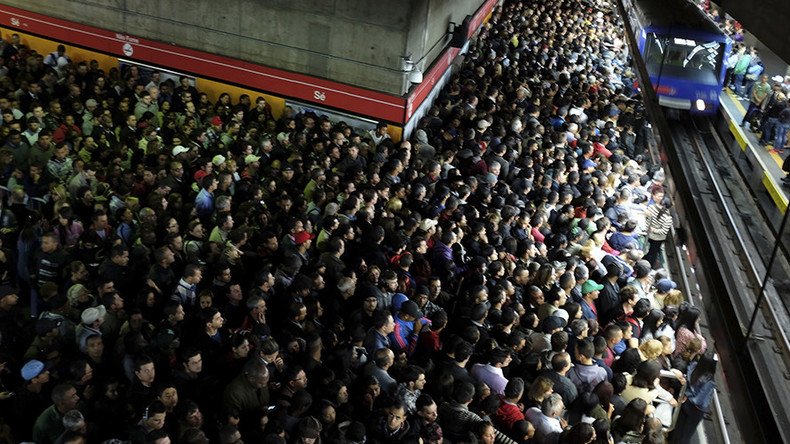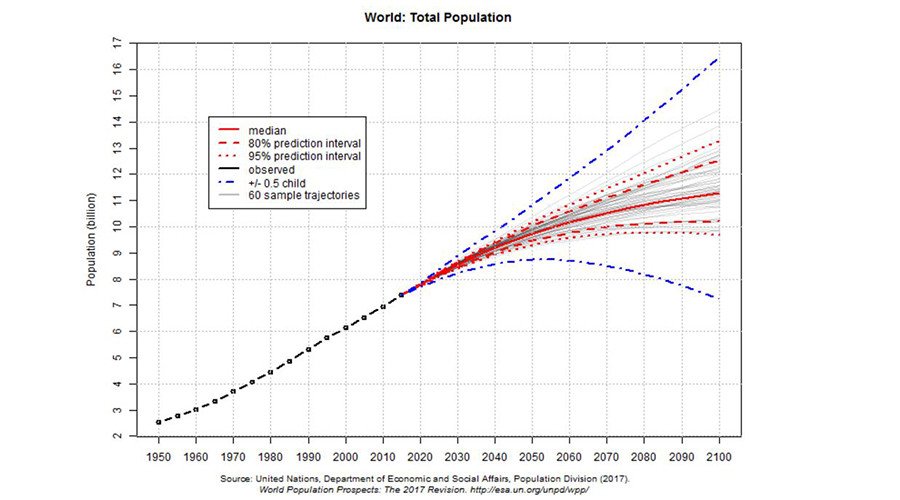‘We need more Earths’: Controversial author’s dire warning as world’s population heads for 11bn mark

On July 11, 1987, eight-pound baby boy Matej Gaspar was born to a couple in Yugoslavia. As commonplace as the event might have seemed at first, its significance was quickly recognized by the United Nations.
It marked the ‘Day of the Five Billion’, the official day the Earth’s population reached that milestone.
Then-UN Secretary General Javier Perez even visited the Zagreb hospital himself to hold baby Matej, and said: “For the first time in our history, we are able to support five billion people. For the first time we can say with confidence that we have the ability to support those who will come after.”
Two decades earlier, controversial American biologist Paul R Ehrlich made the opposite point in ‘The Population Bomb’, a book that made dire predictions about humanity’s ability to feed future generations.
In 1968, he wrote that mankind was on the cusp of breeding itself into oblivion and there was little that could stop a “substantial increase” in the world death rate. He predicted that the children of the 70s and 80s would bear witness to an epoch of famines where “hundreds of millions will starve to death” and, like ancient human civilizations, our numbers were accumulating to the point of an “ecocatastrophe.”
Now, on the 30th anniversary of the ‘Day of the Five Billion’, Ehrlich admits his population predictions were not accurate. In fact, since the release of Ehrlich’s book, every year but one (1992-1993) has seen the world’s crude death rate decrease.
While death rates have not ballooned in general terms, Ehrlich’s questions around sustainable living are similar to the ones being asked today.
READ MORE: 100 companies produce 71% of global emissions - report
Humans are living longer, meaning there is a greater demand for resources. Urban planning is reaching a critical phase and consumption control is the backbone to global treaties like the Paris Agreement.
“Any scientist who writes in 1968 and still believes they’d write the same book on the same topic in 2017 is not much of a scientist,” Erhlich told RT.com.
“I put too much dependence, for instance, on agricultural economists who did not predict how fast the ‘green revolution’ would take. There’s lots of things I’d do differently in the book.
“But the basic story has never been criticized scientifically,” he added. “To [sustain] the number of people we have today at the standards of living we have today… for 50 to 100 years, you’d need one and a half Earths.”
Ehrlich, who once stated how sterilization could be implemented as a form of population control, believes that if the whole world were to consume energy and food at a similar rate to North America – Europe just about lags behind in terms of food wastage – the human race would need to find “four or five more Earths” for survival.
“Every scientist I know thinks there are too many people on the planet and we’re consuming too much and we’re destroying our life support systems by killing off other organisms on the planet,” Ehrlich said. “We’re basically sawing off the limb we are sitting on and the big concern now is can you soften the collapse.”
UN forecast
Last month, the UN released its own population forecast predicting an annual population increase of 83 million people. Over the course of the next 13 years, the global population will grow from 7.6 to 8.6 billion and to 9.8 billion by 2050.
Despite projected decreases in fertility rates in countries with high birth rates, it’s estimated that the population could hit over 11 billion by the start of the 22nd century. Overall, there is just a 27 percent chance the planet’s population will stabilize.

John Wilmoth, Director of the UN Population Division, does not see high population growth as a sign of civilization’s collapse. Rather he views it a “victory over premature death.”
Wilmoth told RT.com that “very little” can actually be done to reduce the total size of the human population, but the key to averting any eco-disaster is changing consumption patterns.
“I really believe that the human population faces major sustainability issues whether we have four billion, seven billion or 11 billion people on this planet. Four billion people would be very capable of messing up this planet, especially if you had four billion people consuming like North Americans or Europeans,” he said.
“A sustainable future for the world has to involve an emphasis on behavioral changes, much more than on reducing the number of people living on the planet.”
Among other things, the UN’s sustainable development goals are concern with ending world hunger. But Wilmoth said the problem is distribution rather than an inability to feed growing numbers.

“The problems tend to be associated with issues surrounding peace and conflict. It’s ultimately political instability that is the cause of much hunger and malnutrition in the world today. It’s not an inability to grow the food, it’s an inability to get the food to those who are in need,” Wilmoth said.
He suggested that limiting family size, like the Chinese government’s former one-child policy, cannot be the answer to ensuring a more sustainable future.
“When you start talking about changing the number of people who are living on this planet, you’re talking about going into people’s bedrooms and interfering with the most private and intimate decisions that people make,” Wilmoth explained.
“To fundamentally change [population] trends would require actions that are just unconscionable – either releasing germs into the population so that a lot of people become sick and die, or forced sterilization of men and women.”
Words by Luke Holohan
Video: Sergio Angulo












